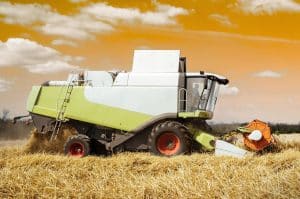The “Systems & Components” section within upcoming Agritechnica tradeshow will offer insights into the digitalisation, automation and networking of mobile work machines. Electrohydraulic and smart driver assist systems open up more autonomy for mobile machines.
From 27 February to 5 March 2022, Systems & Components, which takes place alongside the Agritechnica trade fair in Hanover, Germany, will be offering insights into the digitalisation, automation and networking of mobile work machines: The innovative power of the off-highway industry is focused on the electrification of drives and hydraulic systems, which form the basis for the advanced assistance systems, reducing the driver’s workload. But the solutions on display on the trade fair grounds not only offer excellent vehicle handling and greater efficiency but are also designed to take the machines in the field or on the construction site to the next level of autonomy.
The trends at Systems & Components 2022 include not only the automation of mobile machinery, but also the steadily growing number of intelligent assistance systems. Functions such as crosswind compensation, lane departure warning or hands-on-wheel detection intervene directly in the steering to support the driver and relieve him/her of routine tasks. From 27 February to 5 March 2022, all the major players in the off-highway industries will be showcasing smart and connected technologies that make working in challenging environments not only more productive but also safer. At the Hanover exhibition grounds, this development is reflected in the extensive portfolio of components for the electrification of mobile machinery – an aspect that is also becoming increasingly relevant with regard to the emission and consumption values of heavy commercial vehicles. The range of exhibitors enables OEMs to create versatile and powerful machine architectures and extends from engines and inverters to hydraulic components that operate as compact units with their own electrohydraulic pressure supply and oil circuit, independent of the combustion engine.
Steering and controlling made easy
Electrohydraulic steering valves enable speed-dependent steering assistance and automated driving functions. In this kind of steer-by-wire environment, the valves of the high-pressure circuits can be controlled with electrical commands, so that maintenance-prone hydraulic lines no longer need to be routed into the cab. In the context of autonomously operating machines, industry experts see this technology as the established steering method of the future. In addition, the electrohydraulic systems are optimised to work with GPS, row sensors, line-of-sight sensors or laser technology.
The components presented at Systems & Components cover the entire process from the steering wheel to the steering axle and enable immediate haptic feedback of the steering forces directly to the driver. As with all hydraulic assemblies and systems for use in agriculture, construction or forestry, what counts here is a robust, compact design to guarantee reliable operation under harsh operating conditions. “ActiveCommand Steering 2” is the name of John Deere’s electronic steering system. It exemplifies the latest generation of modern steer-by-wire solutions. It uses a gyroscope to detect the tractor’s yaw and automatically compensates for drift to keep it perfectly on track. This allows drivers to switch the variable steering ratio on and off, adjust the steering sensitivity and tailor the steering wheel resistance to their needs for quick and comfortable headland manoeuvres.
Smart helpers in the cockpit
A look into the cockpit also shows: Drivers have long since stopped holding large steering wheels and levers in their hands. They have been replaced by multifunctional joysticks, mini steering wheels and intuitive touchscreens. They make all information clearly available and turn the cab into a command centre during field work or on the construction site. Unlike the common Orbitrol, electrohydraulic steering valves can receive multiple steering inputs, allowing the most appropriate input to be selected for the intended task. The electrical impulses from the joysticks are processed in real time in the on-board computer and converted into hydraulic movements. This allows the operator to steer the machine on the road with car-like steering, then switch to a more ergonomic alternative when lifting or grading. Ergonomic joystick steering ensures relaxed working, especially during operations with many steering manoeuvres, because its short movements eliminate the need for intensive cranking of the steering wheel.
The extensive range of assistance systems also includes weighing equipment for large wheel loaders. One solution developed by Liebherr is a checkweigher that works automatically and provides information on the loading process. Depending on the application, the ideal weighing range is adjusted automatically and weighing takes place during the regular loading cycle. The machine operator enters the desired target weight on the display and the “Truck Payload Assist” calculates the ideal weight per bucket to be loaded as well as the required number of loading operations. The time-consuming but often necessary shaking in or weighing back of bulk material with the last shovel is no longer necessary. The result is increased productivity through uniform, accurate and machine-friendly loading of trucks or dumpers.
Functionality under extreme conditions
“For end-users to reach the next level of productivity and significantly increase their efficiency, new concepts and technologies are needed,” said Roberto Ferrari, Vice President Service & Operations of TTControl, a joint venture of TTTech Group and Hydac International, which specialises in the development of electronic control units and visualisation solutions for mobile machinery. For Ferrari, the focus is on vehicles that are networked both with each other and with their environment. They are increasingly automated and are standard with features that allow drivers of any experience level to work more efficiently. “Vision 3”, the current display generation from TTControl, is designed to be at the centre of these complex system architectures due to its extensive interfaces. Simultaneous viewing of up to four camera streams helps to significantly expand the view, increasing work safety and efficiency. An excavator operator can, for example, be assisted by a visual representation of the exact position of the boom and excavator bucket in order to dig up or level the subsoil more effectively.
Unlike construction vehicles, agricultural machines often work in groups in close proximity in the field. The assistance systems facilitate operator-independent operation, for example in the form of precision farming with modern crop row recognition or precise movement control. This is made possible by the fusion of different sensor data and the processing of complex image data by high-performance electronic control devices in real time. Using synchronisation based on GNSS (Global Navigation Satellite System), combine harvesters or self-propelled forage harvesters today coordinate the speed and steering of the tractor, which drives alongside a transport trailer, fully automatically. Such a system proves its worth in the dark and on long working days and is particularly interesting for applications which feature constant load transfer.
The autonomous future of machines
The example shows: The technical challenge for developers is to find efficient and economical solutions for the framework conditions in the different off-highway industries. A high degree of automation with the aid of artificial intelligence should help to cope with the increasing demands in the various markets. The algorithms of the assistance systems are taking over more and more functions in mobile machines, making operation more comfortable and work safer. In keeping with the motto “Green Efficiency – inspired by solutions” of Systems & Components 2022, the exhibiting technology suppliers in Hanover are thinking in terms of the future, because in addition to new vehicles, it is also important to equip the existing fleet with electrohydraulic steering systems and smart assistance functions as a retrofit solution – a topic on which the Future Lounge will bring together the leading experts from the agricultural, mining and construction industries in Hanover. The challenges and opportunities currently facing the off-highway industries will be discussed at the Systems & Components specialist forum.

![RightSpot Ad Template Digital-1400×190-px[76] Ag Leader RightSpot](https://world-agritech.com/wp-content/uploads/elementor/thumbs/RightSpot-Ad-Template-Digital-1400x190-px76-r316mmc0hgoob9qxmklllnnbxta1nlj7t2vjkoyeek.png)









